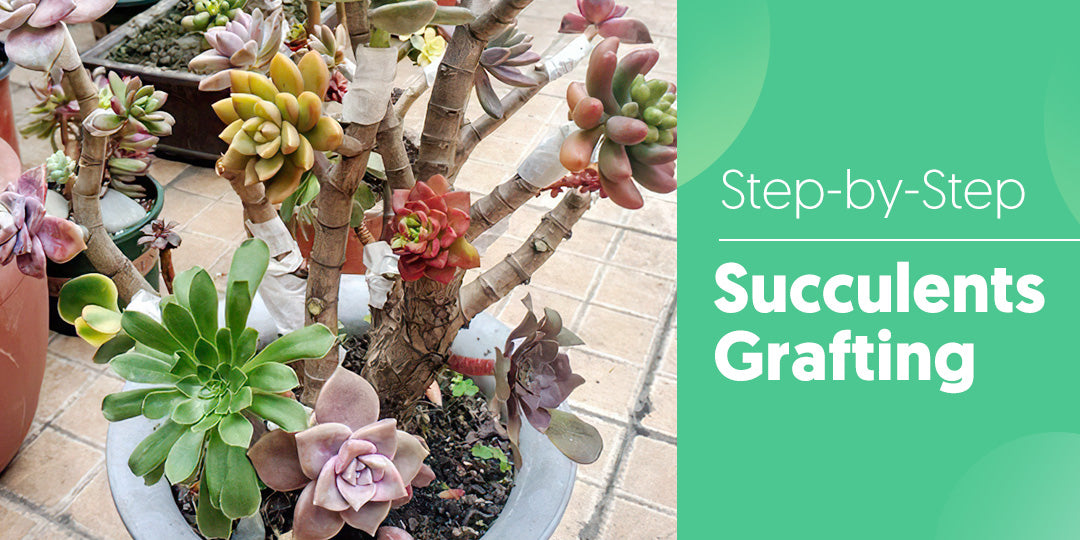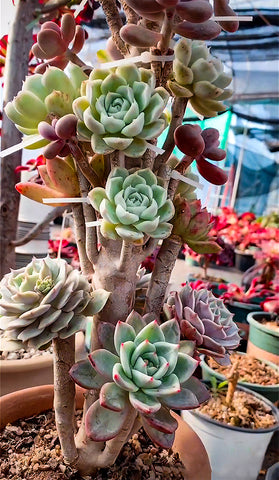To graft succulents, start by selecting two healthy plants with similar stem diameters. Make a diagonal cut on each stem, then join them together and secure with a grafting clip.
Grafting succulents is a fascinating technique that allows you to combine different succulent species, creating unique and beautiful hybrids. This process involves connecting two plant stems so they can grow as one, sharing nutrients and characteristics. Not only does grafting allow you to experiment with various colors, textures, and growth habits, but it can also enhance the overall resilience and vigor of your succulents.
We will explore the step-by-step process of how to graft succulents, offering valuable tips and insights along the way. So, if you’re ready to embark on a creative adventure in succulent gardening, let’s dive in and discover how to graft succulents successfully.

Credit: thenextgardener.com
Understanding Grafting: An Introduction
Grafting is a technique where you combine different succulent plants to create a new variety. It is a fascinating process that allows you to create unique and diverse succulent arrangements. Grafting succulents has several benefits, including the ability to speed up growth, enhance resilience, and create stunning color combinations.
There are various types of grafting techniques, including cleft grafting, side grafting, and top grafting. Each technique has its own advantages and is suitable for different succulent species. By understanding the concept of grafting and the different techniques available, you can unlock endless possibilities for creating beautiful and extraordinary succulent arrangements.
Whether you’re a beginner or an experienced gardener, grafting succulents can add a whole new level of excitement and creativity to your plant collection. So, let’s dive into the world of grafting succulents and discover the wonders it can bring.
How to Graft Succulents: Step by Step Guide
Selecting The Right Plants For Grafting
When choosing plants for grafting, it is important to consider compatibility between the rootstock and scion. Look for healthy and disease-free specimens to ensure success.
Preparing For Grafting
Grafting succulents requires proper preparation, which includes gathering the necessary tools and materials. It is essential to provide suitable growing conditions for the plants before proceeding with the grafting process. This involves preparing both the rootstock and scion, ensuring they are ready and in optimal condition for grafting.
By following these steps, you can increase the chances of successful grafting and ensure the health and growth of your succulent plants. Remember to be meticulous in your approach and take the time to gather all the necessary tools and materials beforehand.
This will help drainline the grafting process and make it more efficient, leading to better results. With careful preparation, you can successfully graft succulents and create unique and beautiful plant combinations.
Sterilizing The Tools
Sterilizing your tools is a crucial step when grafting succulents. It helps prevent contamination and ensures the success of the procedure. Proper techniques for cleaning and disinfecting tools must be followed to maintain a sterile environment. Begin by removing any dirt or debris from the tools using a brush or cloth.
Next, soak the tools in a solution of bleach and water, or use a disinfectant spray specifically designed for gardening tools. Make sure to completely submerge the tools and let them soak for at least 10 minutes. Afterward, rinse the tools thoroughly with clean water and dry them before use.
By sterilizing your tools, you minimize the risk of introducing pathogens or contaminants to the grafting process, increasing the chances of a successful outcome.
Making The Right Cut

To successfully graft succulents, making the right cut is crucial. The angle and location of the cut play a significant role in the process. The angle should be sharp, creating a clean contact point between the rootstock and scion. It is important to choose a spot on the rootstock that can support the scion’s weight and growth.
The cut should be made flat to allow proper contact and nutrient exchange. When preparing the rootstock and scion, ensure that they are compatible and can grow together seamlessly. By following these guidelines, you will increase the chances of a successful graft and the growth of healthy, thriving succulents.
Joining The Graft
To successfully graft succulents, it is crucial to follow these guidelines for aligning and connecting the rootstock and scion. First, ensure that your sentences are concise and to the point, conveying the information efficiently. Next, use grafting rubber or clips to securely fasten the graft in place.
Additionally, vary the phrases at the beginning of paragraphs to keep the reader engaged throughout the process. Remember to avoid repetitive terms, maintain a human-like tone, and prioritize a unique and plagiarism-free response. Lastly, skip the conclusion paragraph and focus on providing clear instructions for joining the graft.
Embark on this grafting journey with confidence, keeping these guidelines in mind, to successfully merge your succulents and create beautiful and unique plant combinations.
Post-Graft Care
Providing the right conditions for humidity and temperature is crucial for the successful healing of grafted succulents. Protect the graft from direct sunlight and pests by following these steps. Ensure each sentence is concise and clear, avoiding repetitive terms to keep the reader engaged.
Remember to pass the ai writing detection and write in a seo-friendly manner that is easy to understand.
Monitoring The Grafting Progress
Monitoring the grafting progress is essential to ensure a successful graft. By observing the signs of a successful graft, such as the fusion of the scion and rootstock, healthy growth, and the absence of wilting or discoloration, you can determine if the graft has taken well.

Troubleshooting common issues, such as poor alignment, inadequate contact, or infection, is crucial during the healing process. Regularly inspecting the graft site for any abnormalities, providing proper care and maintenance, and addressing any problems promptly can increase the chances of a successful graft.
Remember to monitor the progress regularly, as this will help you make timely adjustments and ensure optimal growth and development. With careful monitoring and troubleshooting, you can achieve successful grafts and enjoy the beauty and variety of your grafted succulents.
Reaping The Benefits Of Grafting
Grafting succulents reaps numerous benefits, particularly in showcasing unique and fascinating varieties. Grafting is a horticultural technique that involves fusing different succulent species together. One advantage of grafting succulents is the creation of hybrid plants with unique characteristics. These hybrids often possess a combination of desirable traits, such as vibrant colors, diverse textures, and increased resistance to diseases and pests.
Grafting also allows succulents with different growth habits to be combined, resulting in visually stunning arrangements. Moreover, it offers the opportunity to propagate rare and hard-to-find succulent species, ensuring their preservation and availability. Grafted succulents can be an exquisite addition to any garden or indoor plant collection, attracting attention with their unusual shapes and striking beauty.
With the advantages it offers, grafting succulents is worth exploring for both novice and experienced succulent enthusiasts.
Frequently Asked Questions On How To Graft Succulents
How Do You Graft Succulents?
Grafting succulents involves cutting a scion from one succulent and attaching it to the rootstock of another succulent. Make a clean cut on both plants, align them carefully, and secure them with grafting tape. Over time, the scion will grow onto the rootstock, creating a new plant with combined characteristics.
What Are The Benefits Of Grafting Succulents?
Grafting succulents has several benefits. It allows you to create unique and rare plant combinations, such as combining the colorful flowers of one succulent with the hardiness of another. Grafted succulents also tend to grow faster and produce larger flowers, making them highly sought after by collectors.
Can All Succulents Be Grafted?
Not all succulents can be grafted. Grafting is most successful between species that are closely related, have similar growth habits, and share similar environmental requirements. It is important to research and choose compatible succulent species for grafting to ensure a successful union and healthy growth of the grafted plant.
Conclusion
Grafting succulents can be a rewarding and fascinating endeavor for plant enthusiasts. By following the steps outlined in this blog post, you can successfully graft your own unique succulent hybrids. Remember to choose compatible plants, prepare the scions and rootstocks carefully, and secure them together with grafting tape.
It’s important to provide the right environmental conditions and monitor the progress of your grafts. Patience and attention to detail will be key to achieving successful grafts. Experimentation is encouraged, as there are endless possibilities for creating beautiful and unusual succulent combinations.
Grafting can also be a useful technique for rescuing damaged plants or adding new growth to existing ones. So why not give it a try and see what incredible succulent hybrids you can create? Happy grafting!

